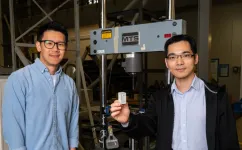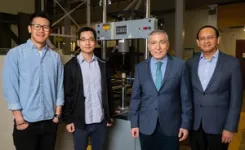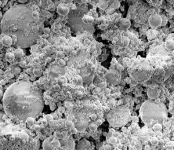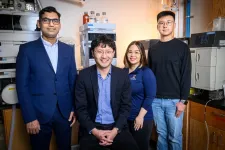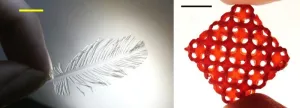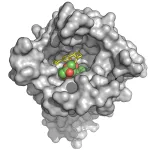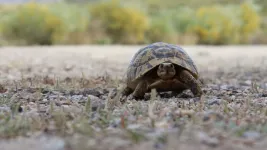(Press-News.org) HOUSTON – (March 28, 2023) – The road to a net-zero future must be paved with greener concrete, and Rice University scientists know how to make it.
The production of cement, an ingredient in concrete, accounts for roughly 8% of the world’s annual carbon dioxide emissions, making it a significant target of greenhouse gas emissions reduction goals. Toward those efforts, the Rice lab of chemist James Tour used flash Joule heating to remove toxic heavy metals from fly ash, a powdery byproduct of coal-based electric power plants that is used frequently in concrete mixtures. Using purified coal fly ash reduces the amount of cement needed and improves the concrete’s quality.
In the lab’s study, replacing 30% of the cement used to make a batch of concrete with purified coal fly ash improved the concrete’s strength and elasticity by 51% and 28%, respectively, while reducing greenhouse gas and heavy metal emissions by 30% and 41%, respectively, according to the paper published in the Nature journal Communications Engineering.
“Reducing emissions from cement production is very important to mitigate global greenhouse emissions,” said lead author Bing Deng, a postdoctoral research associate in the Tour lab. “This is the big picture of this study.”
Rice engineer Satish Nagarajaiah pointed out that “cement production is a significant source of carbon dioxide emissions. Reducing cement content in concrete will help reduce emissions.”
“You can use less concrete if you use coal fly ash. However, fly ash contains heavy metals,” Tour said. “Often, we try to fix one thing and we mess something else up. In our effort to do something with this waste, namely coal fly ash, we were polluting our environment because the heavy metals were leaching out. Water carried it into our environment and contaminated our soil along roadways, etc.”
Roughly 750 million tons of coal fly ash are produced worldwide each year. Rice scientists developed a rapid and water-free process based on flash Joule heating that can remove up to 90% of the heavy metals in it, making it more fit for infrastructure use.
“Basically, we mix the fly ash with carbon black, because fly ash does not conduct electricity, and the carbon black makes the mixture conductive,” Deng said. “Next, we place the mixture between two graphite or copper electrodes and use a capacitor to supply a short current pulse to the sample. This current input brings the sample temperature up to about 3,000 degrees Celsius (5,432 Fahrenheit). The high temperature makes the heavy metals evaporate into a volatile stream which is then captured.
“By using this method, we can eliminate the heavy metals from coal fly ash with very high efficiency,” he continued. “For different heavy metals like arsenic, cadmium, cobalt, nickel and lead, the removal efficiency is up to 70% to 90% in just one second. This is a very rapid discharging process.”
Flash Joule heating was shown to work on different coal fly ash compositions resulting from the combustion of coal extracted from various geographical locations.
“There are two main classes of fly ash with different inorganic compositions, Class C and Class F,” Deng said. “We found that our method works for both kinds of coal fly ash. It also works for other hazardous wastes like red mud or bauxite residue. This shows that the process can become a generalized approach for large-scale industrial solid waste decontamination.”
“The purified coal fly ash is not only better for the environment, but it also increases concrete strength and quality,” said Wei Meng, a Rice civil and environmental engineering postdoctoral research associate and co-lead author on the study. “We have found that by replacing 30% of the cement in a concrete mixture with the purified coal fly ash, the compressive strength and the elastic modulus of the composite increased significantly.
“This is very meaningful for structural engineering and the construction industry because stronger structures can be built with less cement,” he continued. “That is why this research is valuable to civil engineers.”
The Tour lab’s process allows for the evaporated heavy metals to be collected in a vacuum chamber rather than released into the environment. Moreover, the energy consumed during the process is relatively low.
“We calculated that energy consumption is about 532 kilowatts per ton,” Meng said. “If we convert this to Texas electricity prices it comes out at about $21 per ton. The life cycle analysis shows we can actually extract value from these waste materials.”
“It’s a big win for the environment,” Tour said. “You’re reducing emissions, and you’re not leaching heavy metals in the process.”
Satish Nagarajaiah, a Rice professor of civil and environmental engineering and mechanical engineering, and Tour, the T. T. and W. F. Chao Professor of Chemistry and a professor of materials science and nanoengineering in Rice’s George R. Brown School of Engineering, are co-authors on the study.
Other co-authors are Rice alumnus Paul Advincula, Weiyin Chen, Robert Carter, and Gang Li; graduate students Lucas Eddy, Kevin Wyss and Yi Cheng, and U.S. Army Engineer Research and Development Center chemist Mine Ucak-Astarlioglu.
The Air Force Office of Scientific Research (FA9550-22-1-0526) and the U.S. Army Corps of Engineers Engineer Research and Development Center (W912HZ-21-2-0050) and the Shared Equipment Authority (SEA) at Rice University supported the research.
-30-
This release can be found online at news.rice.edu.
Follow Rice News and Media Relations via Twitter @RiceUNews.
Peer-reviewed paper:
Heavy metal removal from coal fly ash for low carbon footprint cement | Communications Engineering | DOI: 10.1038/s44172-023-00062-7
Authors: Bing Deng, Wei Meng, Paul Advincula, Lucas Eddy, Mine Ucak-Astarlioglu, Kevin Wyss, Weiyin Chen, Robert Carter, Gang Li, Yi Cheng, Satish Nagarajaiah and James Tour
https://doi.org./ 10.1038/s44172-023-00062-7
Image downloads:
https://news-network.rice.edu/news/files/2023/03/230313_Deng_-Meng_LG.jpg
CAPTION: Wei Meng (left) and Bing Deng are co-authors on the study. Deng holds a sample of cement made with coal fly ash purified through a flash Joule heating-based process. (Photo by Gustavo Raskosky/Rice University)
https://news-network.rice.edu/news/files/2023/03/2303_Nagarajaiah_Deng_Tour_Meng_LG.jpg
CAPTION: Wei Meng (from left), Bing Deng, James Tour and Satish Nagarajaiah have developed a process to remove toxic heavy metals from coal fly ash, making for greener, stronger cement. (Photo by Gustavo Raskosky/Rice University)
https://news-network.rice.edu/news/files/2023/03/coal-fly-ash-2.jpg
CAPTION: Heavy-metal-free coal fly ash improves cement strength and flexibility. (Photo courtesy of the Tour lab/Rice University)
Related stories:
Potential for profits gives Rice lab’s plastic waste project promise:
https://news.rice.edu/news/2023/potential-profits-gives-rice-labs-plastic-waste-project-promise
Cars could get a ‘flashy’ upgrade:
https://news.rice.edu/news/2022/cars-could-get-flashy-upgrade
Machine learning fine-tunes flash graphene:
https://news.rice.edu/news/2022/machine-learning-fine-tunes-flash-graphene
Flashing plastic ash completes recycling:
https://news.rice.edu/news/2021/flashing-plastic-ash-completes-recycling
Graphene gets enhanced by flashing:
https://news.rice.edu/news/2022/graphene-gets-enhanced-flashing
Links:
Tour Group: https://www.jmtour.com/
Department of Chemistry: https://chemistry.rice.edu/
George R. Brown School of Engineering: https://engineering.rice.edu
Wiess School of Natural Sciences: https://naturalsciences.rice.edu/
Located on a 300-acre forested campus in Houston, Rice University is consistently ranked among the nation’s top 20 universities by U.S. News & World Report. Rice has highly respected schools of Architecture, Business, Continuing Studies, Engineering, Humanities, Music, Natural Sciences and Social Sciences and is home to the Baker Institute for Public Policy. With 4,552 undergraduates and 3,998 graduate students, Rice’s undergraduate student-to-faculty ratio is just under 6-to-1. Its residential college system builds close-knit communities and lifelong friendships, just one reason why Rice is ranked No. 1 for lots of race/class interaction and No. 1 for quality of life by the Princeton Review. Rice is also rated as a best value among private universities by Kiplinger’s Personal Finance.
END
Eco-efficient cement could pave the way to a greener future
Rice U. scientists ‘flash’ toxic heavy metals out of fly ash, make stronger concrete
2023-03-28
ELSE PRESS RELEASES FROM THIS DATE:
Advanced electrode to help remediation of stubborn new 'forever chemicals'
2023-03-28
CHAMPAIGN, Ill. — As new environmental regulations are rolling out to mitigate the industry-retired long-chain chemicals known as PFAS in drinking water, there are concerns regarding a new breed of “forever chemicals” called short-chain PFAS. Research from the University of Illinois Urbana-Champaign is helping shift the focus to include mitigation of the chemicals – which researchers say are just as persistent as, more mobile and harder to remove from the environment than their long-chain counterparts.
A ...
How to prepare for ocean acidification, a framework
2023-03-28
SAN FRANCISCO, CA (March 28, 2023) — In a paper published today in the journal Environmental Research Letters, an international research team composed of scientists affiliated with more than a dozen institutions, including the California Academy of Sciences, propose a first-of-its-kind framework for governments around the world to evaluate their preparedness for—and guide future policies to address—ocean acidification, among the most dire threats to marine ecosystems.
“Ocean acidification is one of climate change’s silent killers,” says Rebecca Albright, PhD, Academy Curator of Invertebrate Zoology and ...
Even Sonoran Desert plants aren’t immune to climate change
2023-03-28
In North America’s hottest, driest desert, climate change is causing the decline of plants once thought nearly immortal and replacing them with shorter shrubs that can take advantage of sporadic rainfall and warmer temperatures.
Many studies have documented how a hotter, drier world is causing a redistribution of plants in temperate mountain regions. A new UC Riverside study documents the unexpected ways plants in part of the Sonoran Desert are doing the same.
“The plants ...
Pulsing ultrasound waves could someday remove microplastics from waterways
2023-03-28
INDIANAPOLIS, March 28, 2023 — Colorful particles of plastic drift along under the surface of most waterways, from headwater streams to the Arctic Ocean. These barely visible microplastics — less than 5 mm wide — are potentially harmful to aquatic animals and plants, as well as humans. So, researchers are devising ways to remove them and to stop them at their source. Today, a team reports a two-stage device made with steel tubes and pulsing sound waves that removes most of the plastic particles from real water samples.
The researchers will present ...
Modern origami method creates glass shapes by folding
2023-03-28
INDIANAPOLIS, March 28, 2023 — The ancient art of origami is well known for transforming sheets of paper and other foldable materials into complex 3D shapes. But now, chemical engineers have extended the centuries-old practice to produce intricate shapes made of glass or other hard materials. Their thoroughly modern method, which can be combined with 3D printing, could have applications ranging from sculpture to catalysis and beyond.
The researchers will present their results today at the spring meeting of the American Chemical Society (ACS). ACS Spring 2023 is a hybrid meeting being held virtually and in-person ...
Marijuana-derived compounds could reverse opioid overdoses
2023-03-28
INDIANAPOLIS, March 28, 2023 — There’s been a recent push in the U.S. to make naloxone — a fast-acting opioid antidote — available without a prescription. This medication has saved lives, but it’s less effective against powerful synthetic opioids, such as fentanyl. In an interesting twist, researchers are now looking to cannabidiol (CBD), a component of marijuana, as a possible alternative to the popular antidote. Today, a team reports compounds based on CBD that reduce fentanyl binding and boost the effects of naloxone.
The researchers will present their results at the spring meeting of the American Chemical Society (ACS). ...
Is it COVID-19 or the flu? New sensor could tell you in 10 seconds
2023-03-28
INDIANAPOLIS, March 28, 2023 — Have a cough, sore throat and congestion? Any number of respiratory viruses could be responsible. Conventional tests can identify certain likely culprits by relying on chemical reactions, but some researchers want to swap chemistry for electrical changes sensed by nanomaterials. Today, scientists report using a single-atom-thick nanomaterial to build a device that can simultaneously detect the presence of the viruses that cause COVID-19 and the flu — at much lower levels and much more quickly than conventional tests for either.
The researchers will present their results at the spring meeting ...
Shedding pounds may benefit your heart — even if some weight is regained
2023-03-28
Research Highlights:
Weight loss was associated with decreased risk factors for cardiovascular disease and Type 2 diabetes for at least five years — even if some weight was regained, according to a review of research on behavioral weight loss programs.
People who lost weight through an intensive behavioral weight loss program had lower systolic blood pressure levels, total cholesterol-to-good cholesterol ratio and HbA1c levels (a diabetes marker), when compared to people who did not participate in a program or participated in a lower-intensity behavioral program.
Embargoed ...
Turtles and crocodiles with unique characteristics are more likely to go extinct
2023-03-28
New research led by the University of Oxford has revealed that the most endangered turtle and crocodile species are those that are most unique. Their loss could have widespread impacts on the ecosystems they live in, since they carry out critical processes important for many other species.
Turtles and crocodiles are two of the world's most endangered animal groups, with approximately half of species globally threatened (International Union for Conservation of Nature, IUCN). Greater understanding on which species are most threatened and why is urgently needed to inform conservation efforts to save them.
In a new study led by researchers at the Department of Biology, ...
A final present from birds killed in window collisions: poop that reveals their microbiomes
2023-03-28
Every year, millions of birds crash into windows in cities along their migratory path. For decades, scientists and volunteers have risen at dawn in spring and fall to collect the fallen birds, rehabilitating the injured and documenting the dead. The bodies of the birds killed in these collisions are a treasure trove of scientific information, especially when compared year after year. A new study in the journal Molecular Ecology makes use of these specimens to help understand the relationship between birds and the microbes living in their guts—which appears ...
LAST 30 PRESS RELEASES:
SIMJ announces global collaborative book project in commemoration of its 75th anniversary
Air pollution exposure and birth weight
Obstructive sleep apnea risk and mental health conditions among older adults
How talking slows eye movements behind the wheel
The Ceramic Society of Japan’s Oxoate Ceramics Research Association launches new international book project
Heart-brain connection: international study reveals the role of the vagus nerve in keeping the heart young
Researchers identify Rb1 as a predictive biomarker for a new therapeutic strategy in some breast cancers
Survey reveals ethical gaps slowing AI adoption in pediatric surgery
Stimulant ADHD medications work differently than thought
AI overestimates how smart people are, according to HSE economists
HSE researchers create genome-wide map of quadruplexes
Scientists boost cell "powerhouses" to burn more calories
Automatic label checking: The missing step in making reliable medical AI
Low daily alcohol intake linked to 50% heightened mouth cancer risk in India
American Meteorological Society announces Rick Spinrad as 2026 President-Elect
Biomass-based carbon capture spotlighted in newly released global climate webinar recording
Illuminating invisible nano pollutants: advanced bioimaging tracks the full journey of emerging nanoscale contaminants in living systems
How does age affect recovery from spinal cord injury?
Novel AI tool offers prognosis for patients with head and neck cancer
Fathers’ microplastic exposure tied to their children’s metabolic problems
Research validates laboratory model for studying high-grade serous ovarian cancer
SIR 2026 delivers transformative breakthroughs in minimally invasive medicine to improve patient care
Stem Cell Reports most downloaded papers of 2025 highlight the breadth and impact of stem cell research
Oxford-led study estimates NHS spends around 3% of its primary and secondary care budget on the health impacts of heat and cold in England
A researcher’s long quest leads to a smart composite breakthrough
Urban wild bees act as “microbial sensors” of city health.
New study finds where you live affects recovery after a hip fracture
Forecasting the impact of fully automated vehicle adoption on US road traffic injuries
Alcohol-related hospitalizations from 2016 to 2022
Semaglutide and hospitalizations in patients with obesity and established cardiovascular disease
[Press-News.org] Eco-efficient cement could pave the way to a greener futureRice U. scientists ‘flash’ toxic heavy metals out of fly ash, make stronger concrete
